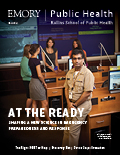The Science of Being Ready
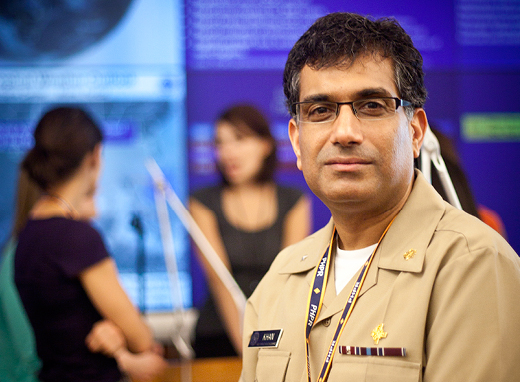
Ali S. Khan leads the CDC’s Office of Public Health Preparedness and Response and co-teaches the Emerging Infectious Diseases course with Ruth Berkelman at Rollins.
By Pam Auchmutey and Robin Tricoles
Rollins experts are defining research and training in emergency preparedness and response
|
|
In the event of a zombie epidemic, Ali S. Khan 00MPH is the go-to expert. Last May, he wrote a CDC blog post playing off the popularity of The Walking Dead TV series filmed in Atlanta. But the message behind the blog was real: reminding the public to prepare at home for possible emergencies.
“The zombie blog was the best $87 ever spent in the history of public health,” says Khan, director of the Office of Public Health Preparedness and Response at the CDC. “We reached 3.6 billion people, who read or heard about the blog. All fun aside, the zombies reminded people how public health protects them every day.”
No one would deny that protecting the public’s health has become an increasingly critical and complex endeavor. A decade ago, 9/11 and the anthrax attacks that followed altered the mindset of public health, law enforcement, and other experts who play a role in emergency preparedness and response. “What changed,” says Khan, “was the recognition of how critical public health is to the security of our nation.”
“It’s not just about preparing for a large, unexplained, or unpredictable event,” he adds. “It’s also about responding to routine public health events every day.”
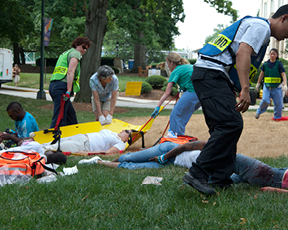
Studies conducted by Rollins researchers provide much-needed scientific evidence to improve how experts and volunteers prepare for and respond to disasters. |
In the past 50 years, the potential and capacity of a few individuals to intentionally harm large populations—through infectious disease agents, chemical weapons, nuclear or radiologic devices, explosives, and tampering with food and water sources—has greatly intensified.
Compounding preparedness worries is the threat of natural disasters such as Hurricane Katrina, wildfires, or the recent tsunami in Japan. The impact of these modern-day disasters has grown more extreme, driven by population density, dependence on goods and services from other countries, climate change, and land-use patterns.
In light of today’s threats, RSPH researchers are growing the science to enhance how communities plan for and respond to disasters and thus strengthen the public health system and community preparedness.
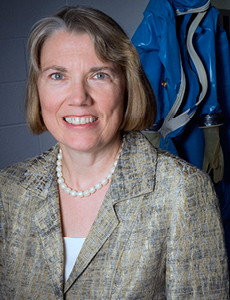
Ruth Berkelman, an expert on emerging infectious diseases, serves on the National Biodefense Science Board and the Homeland Security Review Committee. |
“We have to consider all hazards,” says Ruth Berkelman, Rollins Professor and director of the Center for Public Health Preparedness and Research (CPHPR). “One way we are conducting research is by examining a number of recent disasters, finding ‘lessons learned,’ and sharing them with our partners in public health and the community.”
Before leading the center, Berkelman served as a senior public health official at the CDC and in 2000 became a consultant to the Nuclear Threat Initiative in the area of biologic weapons and disease surveillance, while also teaching the course on Emerging Infectious Diseases at Rollins. Following 9/11, Dean James Curran recruited her to lead the CPHPR, established with a gift from the O. Wayne Rollins Foundation and supported with funding from the CDC, NIH, and other federal agencies. The center encompasses research and training in surveillance, emerging infectious and zoonotic diseases, laboratory safety, preparedness, and public health systems. An interdisciplinary course developed by Berkelman and Hubert Department of Global Health Professor Philip Brachman has educated Rollins students in public health preparedness since 2002. For several years, a seminar series featuring nationally known speakers drew preparedness experts from academia, health care, and public health together each month to discuss common challenges and solutions.
Research and collaborations established by the CPHPR laid the groundwork for receiving a multi-year CDC grant to establish the Emory Preparedness and Emergency Response Research Center (PERRC), one of seven such centers funded in 2008 across the country. These centers were the result of the first federal funding to schools of public health to address the need for an evidence base for public health preparedness programs.
|
"We’re still in a nascent stage of preparedness research. We need to know how people respond. If an event happens in a community, what will make that community more resilient?”—Ruth Berkelman |
||||
“We’re still in a nascent stage of preparedness and disaster research,” says Berkelman, who directs the Emory PERRC. “We need to know how people respond. If an event happens in a community, what will make that community more resilient? How can they rely on their public health department, and how can we make that public health department more potent working in collaboration with others?”
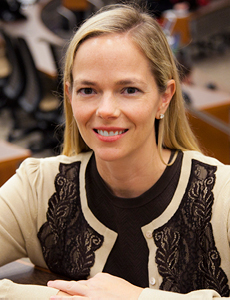
Ellen Whitney, who helped investigate the anthrax attacks in 2001, oversees Rollins’ research projects in emergency preparedness and response. |
Ellen Whitney 01MPH, director of research projects for the CPHPR and associate director of the Emory PERRC, concurs. “We are building new areas of research that will supplement and improve the public health response,” says Whitney, a former CDC epidemiologist who assisted with the 2001 anthrax investigation.
Closing the immunization loop
Four interdisciplinary PERRC projects are building that science. A project led by vaccine safety expert Saad Omer has yielded new best practices and policies, based on the Haemophilus influenzae Type b (Hib) vaccine shortages from 2007 to 2009 and the response to pandemic H1N1 influenza in 2009. To gather evidence, Omer’s team surveyed two groups—immunization program managers (IPMs) and health care providers —with the goal of examining the U.S. immunization system and its capacity for effectively distributing vaccines and other countermeasures during an emergency. Omer’s team includes Alan Hinman, former director of the CDC’s immunization program; project coordinator Katy Seib 10MSPH; and epidemiology doctoral student Allison Chamberlain.
The data that they collected from IPMs on the Hib vaccine shortage suggest that improving vaccine transfer between jurisdictions and using immunization information systems to track compliance with shortage recommendations by providers could help the U.S. immunization system respond more effectively to future vaccine shortages and emergencies.
During a crisis, state health departments turn to their IPMs and emergency preparedness (EP) program managers to respond. In 2010, Omer’s team studied how immunization programs and practices managed the response to H1N1 in 2009.
|
“It’s not just about preparing for a large, unexplained, or unpredictable events. It’s also about responding to routine public health events every day.”—Ali S. Khan |
||||
Researchers considered several factors: vaccine campaign management, collaborations between state immunization and emergency preparedness programs, the use of incident command and emergency operations centers, the use of immunization information systems, and communication with health providers. Based on the results, the Association of Immunization Managers developed new national recommendations for working more closely with EP program managers to improve their response. These recommendations will form the foundation of a national training program to be developed in collaboration with the University of Alabama’s Preparedness and Emergency Response Learning Center.
In Washington state, a survey of health providers showed that pharmacies could play a stronger role during public health emergencies by participating in disaster training, enhancing surge capacity, and improving communication and collaborations in public health.
“The pharmacies stood out as being a big provider in terms of their reach into communities,” says Seib. “They relied less on getting information from local health departments and more on their corporate offices and the CDC for vaccination guidelines during the H1N1 pandemic. They uniformly indicated a desire for more outreach from their local health departments. So there may be a two-way communication gap between local health departments and pharmacies that needs to be addressed.”
During a vaccine shortage or crisis, providers depend on local and state health departments for information. As Omer’s team learned, providers prefer using email, phone, and fax instead of Twitter and text messaging for communication. Early findings regarding communication were quickly disseminated to Washington’s local health departments, which used this information in allocating their increasingly scarce resources. Identifying such factors streamlines the public health response.
In another collaboration, Anne Spaulding, assistant professor of epidemiology and an expert in correctional health care and infectious diseases, worked with Omer and former Rollins student Sunny Lee 11MPH to investigate the preparedness and response of correctional facilities to the H1N1 influenza pandemic. They also documented the need for greater inclusion of jails in public health preparedness planning and response.
As Omer notes, “We’re learning valuable lessons that will raise the quality of evidence to influence policy at the national level and practice at the local level.”
A safety net for nursing homes
When a disaster occurs, what happens to patients who are confined to nursing homes or depend on a home health provider? David Howard, a PERRC project leader and associate professor of health policy and management, is looking at ways to improve disaster planning for both types of providers.
“There’s a great deal of attention paid to hospitals in preparedness,” says Howard. “This is a chance to focus on a segment of the provider community that has received little attention previously.”
In San Diego, nursing homes have banded together to share resources and information during a disaster in order to know who has supplies and available beds. “One of the real strengths of the model is that preparedness planners meet before a disaster occurs and build up a community of informal ties they can draw on when disaster strikes,” says Howard. “We think this might be a good model for other jurisdictions to follow because it doesn’t tax government resources.”
|
|
Howard’s research team, which includes senior associate Sarah Blake and research project coordinator Hilary Eiring 09MPH, surveyed 296 nursing homes in California, Florida, and Georgia—all disaster-prone states—about their preparedness planning and capabilities. In coastal Georgia, many nursing homes rely on the same transportation providers, such as ambulances and buses, for evacuation.
“While both of these modes of transportation would provide effective transport during a small-scale, localized disaster, reliance on these same providers would be problematic during a region-wide disaster when other people and facilities require the same services,” says Eiring. Evacuating patients to a local hospital would be impossible because they frequently discharge patients, often to nursing homes, in order to prepare for a surge.
“Doing a better job of system-wide planning is an important step going forward,” says Howard.
Commanding the situation
In 2009, San Diego became ground zero for H1N1 in the United States. The cases spread from neighboring Mexico, where H1N1 was first detected. San Diego County’s response to the potential pandemic makes for a compelling case study in an Emory PERRC project led by Professor Kathy Miner 79MPH, associate dean for applied public health, along with co-investigator Ariela Freedman, assistant research professor of behavioral sciences and health education, and project coordinator Michele Mindlin, associate director of research projects in epidemiology.
“The H1N1 cases in San Diego marked the first time that public health assumed the lead emergency management role in a major event. We didn’t expect ‘ground zero’ in the U.S. to emerge in this way, and events didn’t unfold as anticipated,” says Miner, whose project looks at how incident command systems (ICSs) and emergency operations centers (EOCs) are used in response to public health crises.
|
“What 9/11 and anthrax made clear is that public health is a primary response agency.”—Kathy Miner |
||||
When the first case of H1N1 was identified, San Diego County public health officer Wilma Wooten stepped up to ensure coordination of activities in the county health department and with local hospitals and community providers. Wooten quickly established an EOC and organized county public health staff into an ics structure to meet the epidemiologic and disease control challenges.
Through case studies of H1N1 in San Diego and the 2009 ice storm in Kentucky, Miner’s team is determining best practices in emergency planning and response. Using both qualitative and quantitative methods, the investigators and the National Association of County and City Health Officials are surveying state and local health departments to assess their use of ICSs and EOCs.
As Mindlin explains, “We’re asking, ‘Did you use incident command? Did you open an emergency operations center? And as a result of your experience, how are you looking at emergency response as part of the evolving core mission of public health?’ Their answers will tell us whether the training and preparation that has happened thus far may be changing the way they think about public health in the future.”
|
|
Miner has done her own share of preparedness training. From 2002 to 2010, she and Melissa Alperin 91MPH led the CDC-funded Center for Public Health Preparedness (CPHP). The center excelled in using technology to train Georgia’s public health workforce via podcasts, CD-ROMS, web-based lectures, case studies, and other types of interactive training. Since its inception, CPHP has distributed more than 57,000 copies of instructional materials to state and local public health workers in Georgia and the nation. In addition, the center provided leadership training to county and district public health nurses and engaged leaders from Georgia nursing schools and programs in discussions about curriculum issues in emergency preparedness and response.
Among CPHP’s most popular training materials was Master the Disaster, an interactive CD series co-developed with colleagues at the Advanced Practice Center located at the DeKalb County Board of Health. CPHP also created Emerging Threats in Public Health, a series of CD training modules on bioterrorism, chemical terrorism, radiological and nuclear terrorism, explosives, agroterrorism, influenza, and water.
“What 9/11 and anthrax made clear is that public health is a primary response agency,” says Miner. “When that awareness occurred, there was an understanding that we have to prepare the public health workforce on how to assume this role.”
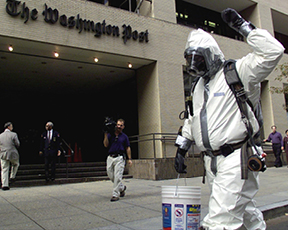
A biosafety expert is suited up to investigate the spread of anthrax bacteria (shown above) through the mail in Washington, D.C., in 2001. Photo by Stephen Jaffe/AFP/Getty Images. |
Schooled in disasters
In August 2005, the massive flooding caused by Hurricane Katrina forced thousands of Gulf Coast evacuees into Georgia. The Emory community rallied to cushion the evacuees’ arrival.
Emory’s response led Alexander Isakov, associate professor of emergency medicine, and Anne Dunlop, assistant professor of family and preventive medicine, to undertake a PERRC project exploring how colleges and universities can collaborate with disaster response agencies to increase and sustain community readiness and response.
“Traditionally, academic institutions are viewed as providing education and training for preparedness,” says Isakov, executive director of Emory’s Office of Critical Event Preparedness and Response. “But we believe they’re an often-overlooked community partner when response agencies are seeking to solve their disaster response needs.”
Those needs are vast and diverse: physical resources, such as shelter for evacuees; a solid public communications infrastructure; robust Internet technology resources; and subject matter expertise in public health, clinical and veterinary medicine, engineering, nursing, theological and pastoral care, and language translation.
Although an array of expertise is needed to effectively manage disaster response, all disasters have fundamental managerial elements that must be met. One is physical stability, a crucial aspect of disaster preparedness that is often overlooked.
“The fact that colleges and universities are part of the community and don’t typically relocate make them an ideal partner to public health agencies,” says Isakov.
|
“The fact that colleges and universities are part of the community and don’t typically relocate make them an ideal partner to public health agencies.” —Alexander Isakov |
||||
Through PERRC, Isakov’s team looked at several FEMA-declared disasters to compare academic institutions that partnered with public health response agencies and those that did not during specific events. Those events include the 2009 Kentucky ice storm, Hurricanes Gustav and Ike in 2008, the 2007 California wildfires, and the Columbia shuttle disaster in 2003.
The researchers found that having a shared response plan and shared field training helps schools and agencies work together more effectively. They also found that central coordination of academic institutions’ resources facilitates collaborative action with the public health response agency. For example, if a public health agency needs to distribute drugs for prophylaxis or post-exposure, schools could leverage their communications and logistics infrastructure to distribute the drugs to the community, reaching tens of thousands of people in some cases.
Because funding and preparation for disasters are cyclical, establishing relationships and cooperative plans before a disaster is essential, especially when funding is tight.
“Relationships are key,” says Berkelman. “Although we have different cultures, we’ve learned to understand each other and work together far better than 10 years ago.”
Her observation is timely, given that federal funding for preparedness research and training at schools of public health has been targeted for elimination in 2012 because of budget cuts. But the need to secure the scientific evidence for preparedness programs remains. As RSPH Dean James Curran notes, “We must know what works in our communities to keep them safe.”

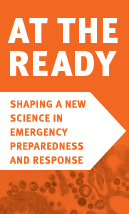

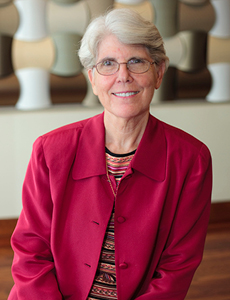 Kathy Miner leads a research project examining the role of incident command systems and emergency operation centers during public health crises.
Kathy Miner leads a research project examining the role of incident command systems and emergency operation centers during public health crises.